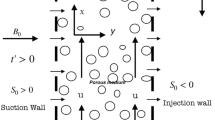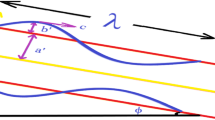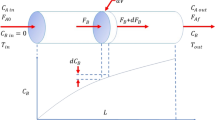Abstract
Fluid transport systems such as pipelines are subject to loads whenever changes in fluid momentum or in pipeline structure occur. These loads can generate extremely harmful hydraulic transients which may be responsible for several major accidents. This paper presents a model for the solution of these hydraulic transients, considering two-phase flow and fluid–structure interaction. Mathematical and numerical solutions are proposed and analyzed for the proper capture of the physical phenomena associated with the fluid compressibility and fluid celerity, which are variable in two-phase fluid, together with the disturbances generated by the fluid–structure interaction. The proposed solution for the model considers the simultaneous action of these phenomena. The developed numerical model is based on the solution of the mathematical model formed by a system of four partial differential equations, in which the necessary adaptations are integrated in fluid–structural equations and in the nonlinear mathematical coefficients for the solution of the compressible and two-phase flow in question. Classical formulation is selected for the implementation of friction between fluid and pipe in the model. For the solution, it is applied the method of characteristics and finite difference, with subsequent numerical integration. The validation of the results is carried out based on comparisons with experimental and analytical data. The model presented, in general, was quite adherent to the experimental and analytical results, mainly in relation to the first pressure peak, which is one of the main focuses of the transient analyses.

Source: Author

Source: Author

Source: Author

Source: Author

Source: Author

Source: Author
Similar content being viewed by others
Availability of data and materials
The manuscript has no associated data in a data repository.
Abbreviations
- A :
-
Previous point, pipe transversal area
- f :
-
Darcy–Weisbach friction coefficient
- t :
-
Time
- V :
-
Average fluid speed [m/s]
- \(\forall\) :
-
Volume
- P :
-
Average pressure [Pa]
- L :
-
Pipe length [m]
- c :
-
Celerity
- Δ :
-
Variation of a given entity
- ρ :
-
Density [kg/m3]
- g :
-
Gravity acceleration [m/s2]
- K ut :
-
Time adjustment coefficient
- K ux :
-
Length adjustment coefficient
- R :
-
Pipe internal radius
- D :
-
Pipe internal diameter [m]
- e :
-
Pipe thickness [m]
- E :
-
Pipe Young modulus (elasticity modulus)
- \(\nu\) :
-
Poisson coefficient
- \(p\) :
-
Absolute pressure
- K :
-
Bulk modulus
- \(\gamma\) :
-
Pipe angle
- \(\tau_0\) :
-
Friction term
- i,cur:
-
Counters
- j :
-
Time counter
- \(\alpha \) :
-
Void fraction
- \(K_v\) :
-
Valve pressure loss coefficient
- \(Cd\) :
-
Outlet valve coefficient
- m :
-
\(Cd\) Adjustment coefficient
- val:
-
Valve
- \(u,U\) :
-
Pipe displacement
- \(\sigma\) :
-
Axial stress
- N :
-
Number of pipe sub-elements
- λ :
-
Wavelength
- z :
-
Axial coordinate
- t :
-
Time coordinate
- \(\frac{{\text{d}}}{{{\text{d}}t}}\) :
-
Time total derivative
- \(\frac{\partial }{\partial t}\) :
-
Partial derivative in relation to t coordinate
- \(\frac{\partial }{\partial z}\) :
-
Partial derivative in relation to z coordinate
- 1,2,3,4:
-
Characteristics curves
- o :
-
Reference to beginning
- F,f :
-
Fluid
- t :
-
Pipe
- g :
-
Gaseous phase
- l :
-
Liquid phase
- out:
-
External
- max:
-
Maximum
- min:
-
Minimum
- rel:
-
Relative
- c :
-
Valve closure
- d,D :
-
At right
- e :
-
At left
- \((i,j)\) :
-
Position and time indicators in computational mesh
- cur, i :
-
Counter
- cond:
-
Condition
- points:
-
Number of points
- z :
-
Axial direction
- m :
-
Mixture
- ~ :
-
Adjusted value
- .:
-
First derivative in time
- -:
-
Average value at transversal section
- |:
-
Taken at
- IAB:
-
Instantaneous acceleration based
- FSI:
-
Fluid–structure interaction
- MOC:
-
Method of characteristics
References
Bonin CC (1960) Water-hammer damage to Oigawa power station. J Eng Power 82:111–116. https://doi.org/10.1115/1.3672721
van Duyne DA, Merilo M (1996) Water hammer handbook for nuclear plant engineers and operators. Electric Power Research Institute (EPRI), TR-106438
Oloruntoba O, Kara F (2017) Simplified transient two-phase model for pipe flow
Tijsseling AS (2003) Exact solution of linear hyperbolic four-equation system in axial liquid-pipe vibration. J Fluids Struct 18:179–196
de Almeida RSP (2018) Modelo numérico para cálculo do Transitório Hidráulico e Interação Fluido-Estrutura em sistemas de transporte de fluidos. Dissertação de Mestrado, Universidade de São Paulo (USP)
Tijsseling AS (1993) Fluid-structure interaction in case of water hammer with cavitation. Ph.D. Thesis
Chaudhry MH (2014) Applied hydraulic transients, 3rd edn. Springer, New York
Chaudry MH, Bhallamudi SM, Martin CS, Naghash M (1990) Analysis of transient pressures in bubbly, homogeneous, gas-liquid mixtures. J Fluids Eng 112:225–231
Fernandes LS (2017) Medição do Campo de Velocidade do Líquido no Escoamento Bifásico, Intermitente, em Duto Horizontal, Utilizando Velocimetria Estereoscópica. Tese de Doutorado, PUC-Rio
Thorley ARD (2004) Fluid transients in pipeline systems: a guide to the control and suppression of fluid transients in liquids in closed conduits, 2nd edn. Professional Engineering Publishing Limited, London
Záruba J (1993) Water hammer in pipe-line systems. Elsevier, Amsterdam
Acknowledgements
The authors thank for the Brazilian Navy support and for the data kindly shared by Eindhoven University of Technology (Netherlands) and Georgia Institute of Technology (USA).
Funding
This research did not receive any specific grant from funding agencies in the public, commercial or not-for-profit sectors.
Author information
Authors and Affiliations
Contributions
Each author contributed to the research presented in this manuscript, approved the contents now presented and agreed to the compliance with ethical standards.
Corresponding author
Ethics declarations
Conflict of interest
The authors also declare that they have no competing financial interests or personal relationships that could have influenced this research.
Consent to publish
Both authors consent to the manuscript's publication in the JBSMSE, should the article be accepted by the Editor upon completion of the refereeing process.
Ethical approval
The manuscript is original and has not been submitted for publication elsewhere (partially or in full). Also, the manuscript has not been submitted to more than one publication for simultaneous consideration.
Additional information
Technical Editor: Erick Franklin.
Publisher's Note
Springer Nature remains neutral with regard to jurisdictional claims in published maps and institutional affiliations.
Rights and permissions
Springer Nature or its licensor (e.g. a society or other partner) holds exclusive rights to this article under a publishing agreement with the author(s) or other rightsholder(s); author self-archiving of the accepted manuscript version of this article is solely governed by the terms of such publishing agreement and applicable law.
About this article
Cite this article
do Nascimento Rocha, P.H., de Campos, J.A.A., Camargo, M.R. et al. Numerical model for calculation of hydraulic transients with two-phase flow and fluid–structure interaction. J Braz. Soc. Mech. Sci. Eng. 46, 206 (2024). https://doi.org/10.1007/s40430-024-04818-w
Received:
Accepted:
Published:
DOI: https://doi.org/10.1007/s40430-024-04818-w




